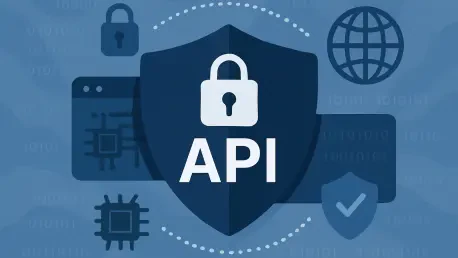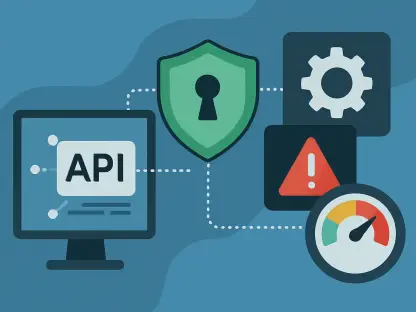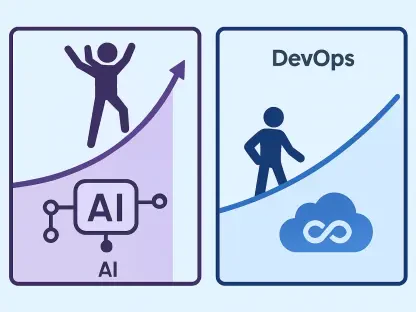In the ever-evolving digital landscape of today, Application Programming Interfaces (APIs) stand as the invisible yet indispensable connectors that power modern business operations, linking everything from mobile applications to intricate cloud-based services with remarkable efficiency. Astonishingly, around 85% of applications depend on APIs to function, positioning them as the linchpin of digital transformation across industries. These interfaces enable seamless data exchange and integration, driving innovation at an unprecedented pace. However, this critical role also makes them a prime target, as cybercriminals increasingly exploit vulnerabilities in APIs to access sensitive information. As businesses lean more heavily on these digital conduits to stay competitive, the urgency to fortify API security has surged to the forefront. The potential fallout from a single breach—ranging from financial losses to eroded customer trust—underscores the stakes involved. This pressing reality sets the stage for a deeper exploration into why safeguarding APIs is not just a technical necessity but a cornerstone of sustainable business success.
The Backbone of Digital Operations
The role of APIs in today’s digital ecosystem cannot be overstated, as they serve as the fundamental infrastructure that enables communication between disparate systems like web applications, mobile platforms, and cloud services. Often likened to the plumbing of the digital world, APIs facilitate the smooth flow of data, allowing businesses to integrate services, enhance user experiences, and accelerate operational efficiency. Their pervasive presence underpins nearly every digital interaction, from online transactions to real-time data syncing. Yet, this very pervasiveness transforms APIs into attractive targets for malicious actors. With critical and often sensitive data coursing through these channels, a breach can have catastrophic consequences, disrupting operations and exposing vulnerabilities across an organization. The challenge lies in recognizing that while APIs drive innovation, they also represent a significant risk if left unsecured, demanding attention from every level of a business to prevent exploitation.
Beyond their technical function, APIs have become a strategic asset for companies aiming to stay ahead in a competitive market, but this comes with heightened exposure to cyber threats that can undermine growth. Their ability to connect microservices and enable modular architectures empowers organizations to scale rapidly and adapt to changing demands. However, the sheer volume of API interactions means that even a minor oversight can open the door to devastating attacks, such as data theft or system sabotage. Cybersecurity reports consistently highlight how attackers exploit poorly protected APIs to gain unauthorized access, often targeting outdated or misconfigured endpoints. This dual nature of APIs—as both enablers of progress and potential weak points—requires a proactive approach to security. Businesses must prioritize robust measures to safeguard these interfaces, ensuring that the drive for digital advancement does not come at the cost of compromised safety or eroded stakeholder confidence.
AI-Driven Complexity and API Proliferation
The rapid rise of artificial intelligence (AI), particularly agentic AI, has dramatically amplified the use of APIs, creating intricate webs of connectivity often referred to as the “API fabric” that spans across digital environments. AI agents leverage protocols such as the Model Context Protocol (MCP) and application-to-application (A2A) interactions to exchange vast amounts of data, fueling a significant spike in API traffic. This surge enhances operational efficiency by automating processes and enabling real-time collaboration between systems. However, it simultaneously introduces a labyrinth of security challenges that many organizations struggle to navigate. The dynamic and frequently opaque nature of these AI-driven interactions complicates efforts to monitor and protect API endpoints. As a result, vulnerabilities can go unnoticed, leaving systems exposed to sophisticated threats that exploit the very connectivity APIs are designed to provide.
Compounding this issue is the sheer scale of API proliferation driven by AI, which often outpaces the ability of businesses to implement adequate security measures tailored to these new complexities. The intricate call paths generated by AI agents create a sprawling network that is difficult to map, let alone secure, as interactions multiply across platforms and services. This lack of clarity can obscure potential risks, allowing threats to fester undetected in the shadows of an organization’s digital infrastructure. Emerging standards like MCP, while facilitating AI collaboration, add further layers of intricacy to an already challenging landscape. Enterprises find themselves grappling with the dual task of harnessing AI’s potential while mitigating the risks it introduces through increased API exposure. Addressing this demands advanced tools and strategies that can keep up with the rapid evolution of technology, ensuring that innovation does not inadvertently pave the way for costly breaches.
The Imperative of Visibility and Governance
Securing APIs begins with a fundamental yet often overlooked step: achieving complete visibility into where these interfaces exist and how they are utilized within an organization’s ecosystem. Experts emphasize that without a clear understanding of the API landscape, businesses remain blind to potential risks, including “zombie APIs”—outdated or abandoned endpoints that linger as unsecured backdoors for attackers. These forgotten assets can pose significant threats if exploited, as they often lack updates or monitoring. Visibility provides the foundation for identifying active and inactive APIs, enabling companies to assess their security posture accurately. This insight is critical in a digital environment where APIs are deployed at scale, often across multiple platforms and teams, making manual tracking nearly impossible. Automated solutions that offer real-time monitoring are becoming essential to uncover hidden vulnerabilities before they are targeted.
Equally important is the role of governance in establishing a structured approach to API management, ensuring that security standards are consistently applied across all interfaces. Governance frameworks help define policies for API development, deployment, and maintenance, reducing the likelihood of misconfigurations that cybercriminals frequently exploit. This becomes even more vital as new AI-driven protocols and interactions emerge, adding complexity to the security landscape. Strong governance ensures that APIs adhere to best practices, such as encryption and authentication, while also facilitating regular audits to detect anomalies. By combining visibility with governance, organizations can create a robust defense against threats, proactively addressing risks rather than reacting to breaches after they occur. This dual focus is indispensable for maintaining the integrity of digital operations, especially as the reliance on APIs continues to grow in tandem with technological advancements.
Industry Innovations and Collaborative Defenses
In response to the escalating challenges of API security, forward-thinking companies like Salt Security are pioneering solutions that focus on discovering, governing, and protecting these critical interfaces from malicious activities. By emphasizing comprehensive API management, such innovations aim to close the gaps that attackers often exploit, offering tools that provide deep insights into traffic patterns and potential threats. Strategic partnerships with industry leaders like CrowdStrike further enhance these efforts, integrating API security with advanced platforms such as the Falcon system. This collaboration delivers unified visibility across both API interactions and AI-driven workflows, creating a more cohesive defense against a spectrum of cyber risks. Such alliances reflect a broader industry shift toward integrated solutions that combine expertise and technology to address the multifaceted nature of modern threats.
These collaborative approaches underscore the importance of a united front in tackling API vulnerabilities, as no single entity can combat the evolving threat landscape alone. Partnerships enable the sharing of threat intelligence and the development of interoperable systems that enhance security across ecosystems, from traditional endpoints to emerging AI interactions. This trend toward unity is evident in the integration of API protection with next-generation Security Information and Event Management (SIEM) systems, which offer real-time threat detection and response capabilities. By leveraging such synergies, businesses can better safeguard their digital assets against both known and novel attacks. The emphasis on collaboration also signals a recognition that API security is not merely a technical issue but a strategic imperative, requiring coordinated efforts to ensure that protective measures evolve alongside the rapid pace of digital transformation.
Navigating the Tightrope of Innovation and Risk
As APIs cement their status as the foundation of nearly every digital interaction, businesses face the intricate challenge of balancing the pursuit of innovation with the management of inherent risks. The exponential growth of API usage, propelled by AI advancements, has led to an unprecedented multiplication of vulnerabilities that can be exploited if not addressed. Each new API endpoint represents both an opportunity for enhanced functionality and a potential entry point for attackers, creating a delicate tightrope that organizations must navigate. The rush to adopt cutting-edge technologies often overshadows the need for robust security frameworks, leaving systems exposed to breaches that can undermine years of progress. Prioritizing security alongside innovation is essential to ensure that the benefits of digital expansion are not negated by preventable threats lurking within unprotected interfaces.
This balance requires a forward-thinking mindset, where security is embedded into the development and deployment of APIs from the outset, rather than treated as an afterthought. Enterprises must invest in scalable frameworks that can adapt to the evolving landscape, incorporating real-time monitoring and automated threat detection to stay ahead of risks. The dynamic nature of the “API fabric” demands agility, as static defenses quickly become obsolete in the face of sophisticated attacks. By fostering a culture of security awareness across all levels of an organization, businesses can mitigate the tension between rapid technological adoption and risk exposure. This proactive stance ensures that APIs continue to serve as engines of growth without becoming liabilities, safeguarding both operational integrity and customer trust in an era where digital interactions define success.
Forging a Secure Path Forward
Reflecting on the journey through the intricate world of API security, it becomes evident that businesses must confront a landscape where these interfaces are both vital to progress and susceptible to exploitation. The surge in API usage, driven by AI innovations, has intensified risks, exposing organizations to breaches that could derail operations. Industry leaders like Salt Security have risen to the occasion, offering solutions that emphasize visibility and governance, while partnerships with entities like CrowdStrike have fortified defenses through integrated platforms. Moving forward, enterprises should focus on embedding security into every stage of API development, adopting automated tools for real-time threat detection, and fostering cross-industry collaborations to share insights. By prioritizing scalable and adaptive frameworks, companies can ensure that APIs remain a source of strength rather than vulnerability, paving the way for sustained digital success in a threat-laden environment.









